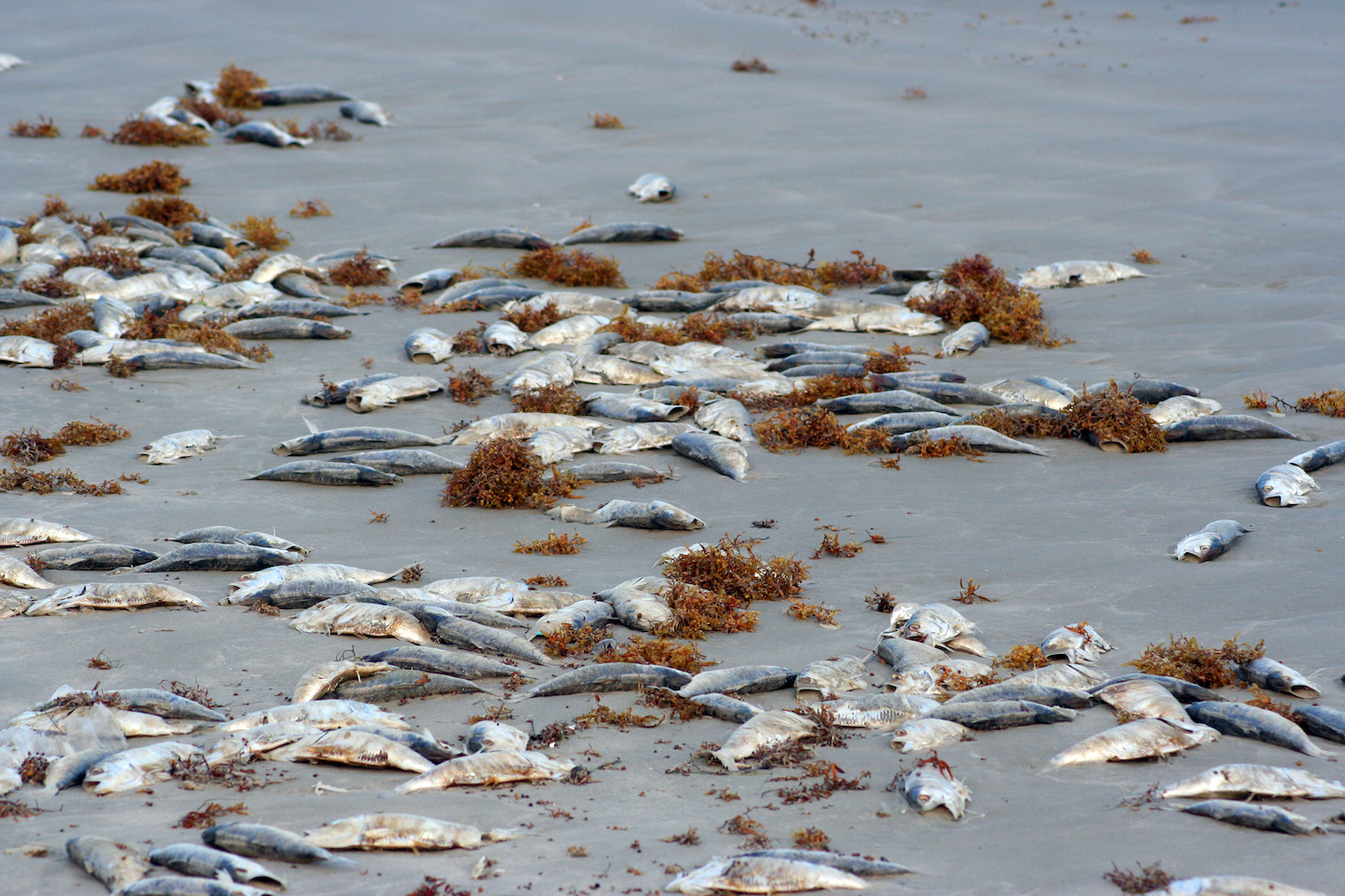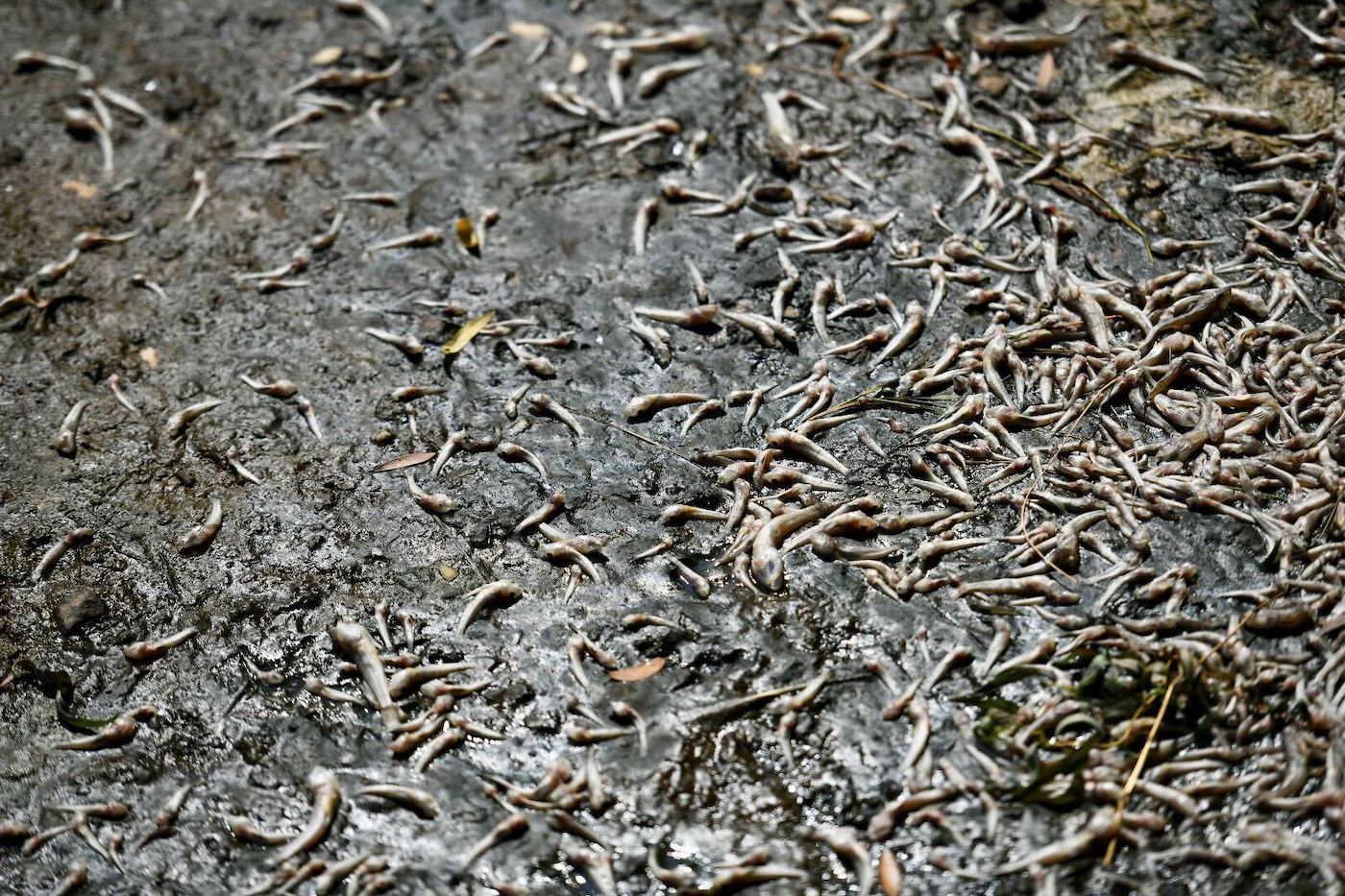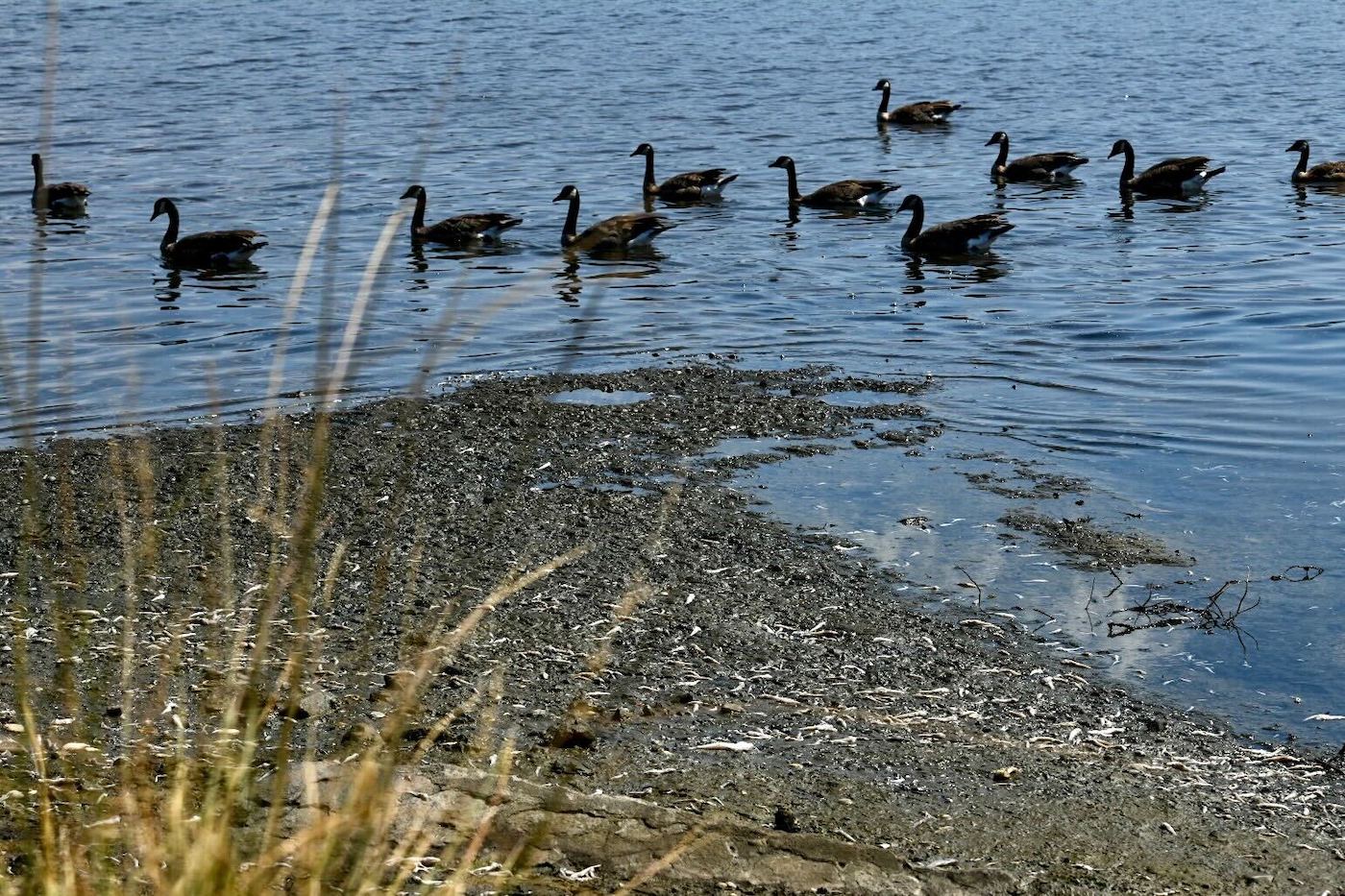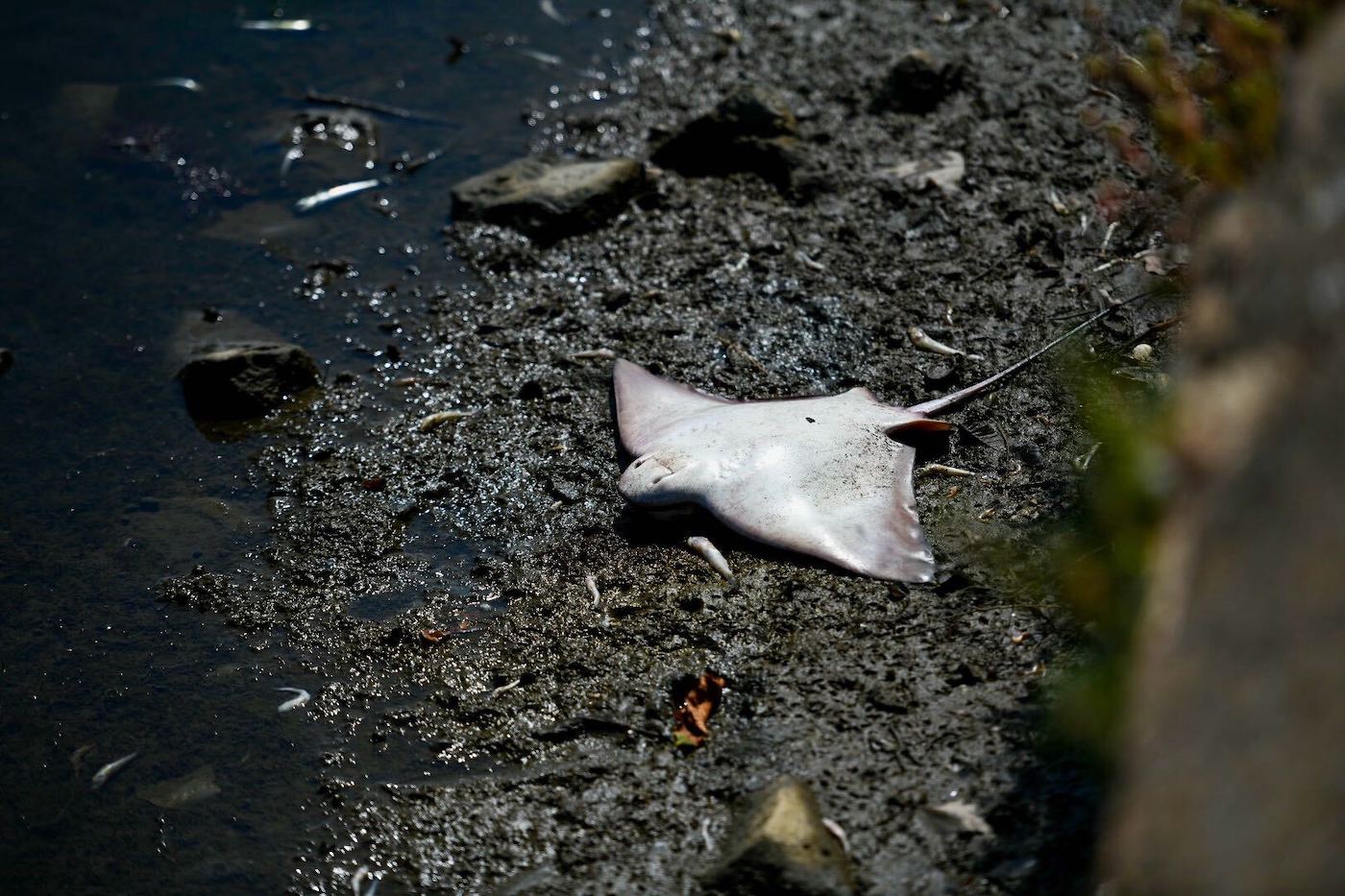Why Are Dead Fish Piling Up Across The San Francisco Bay?
7:21 minutes
This article is part of The State of Science, a series featuring science stories from public radio stations across the United States. This story, by Joe Fitzgerald Rodriguez, was originally published by KQED.

Thousands of dead fish are piling up across the Bay Area.
From the concrete outer edges of Oakland’s Lake Merritt to the sandy beaches of San Francisco’s Fort Funston and the pebbled banks of Oyster Point in San Mateo County, the carcasses of fish likely poisoned by a harmful algal bloom — more commonly known as a red tide — are washing ashore.
It’s a mass-death event the San Francisco Bay hasn’t seen the likes of in years, says Jon Rosenfield, senior scientist with environmental group San Francisco Baykeeper.
“From a fish’s point of view, this is a wildfire in the water,” he said.
By SF Baykeeper’s count, the number of fish dying off in the San Francisco Bay could easily exceed hundreds of thousands, and that, Rosenfield said, might even be a “low” estimate.
His field investigator confirmed “easily tens of thousands of fish dead” in Lake Merritt alone. But Rosenfield cautioned, “What you see is just the hint of what’s actually happening further beneath the water’s surface and in places you’re not getting to on the shoreline. So it’s really an uncountable number.”
It may be harmful to humans, too. An algal bloom of this size can cause skin irritation and respiratory problems, and the San Francisco Bay Regional Water Quality Control Board is advising people to avoid swimming, kayaking or other activities on the water until the bloom subsides.
Mary Spicer of Alameda, who paddles on the bay with an outrigger canoe team, said some members of her team have been experiencing skin irritation after coming into contact with the water over the past few weeks. Spicer said she began to notice discoloration of the water about a month ago — and then it turned to a “denser, thicker, chocolaty brown.”
Paddling at the Oakland Estuary a couple weeks ago, she was heartbroken to see a juvenile harbor seal poking its head out of the discolored water. “Just to see these marine creatures … having to live in the red, brown, dense water, it’s really just disconcerting,” she said.

The National Oceanic and Atmospheric Administration describes red tides as a “harmful algal bloom,” or large colonies of algae plants growing out of control that are sometimes rust-colored. Not all algal blooms are harmful, and most are beneficial in the ocean.
However, a small percentage of algae can produce deadly blooms, and that’s what Rosenfield believes may be happening now.
SF Baykeeper is getting reports through its pollution hotline of dead fish in Foster City, Alameda, Keller Beach in Richmond, Sausalito and Fort Baker.
“Whatever number I offer you would likely be too low,” Rosenfield said.
Government officials KQED reached would not confirm any number yet. But on Monday, Eileen White, executive officer at the San Francisco Bay Regional Water Quality Control Board, described the algae bloom as “highly unusual” and “much more extensive” than blooms the agency has tracked in the past.
“And this one’s resulting in fish kills, which is not good,” she said. “So we’re going to continue to study, try to find the cause of it and learn from this, so hopefully we can prevent them in the future.”
Damon Tighe, who describes himself on his LinkedIn profile as an educator and a naturalist who studies mycology, tweeted a photo of a pile of dead fish at Lake Merritt on Sunday.
“Massive fish die off going on right now in Lake Merritt,” tweeted Tighe. “May be related to the HUGE algal bloom that’s been happening on the east bay since the start of the month in front of Alameda where effluent flows.” Tighe included a link to iNaturalist, a nature app that allows users to share their observations with other scientists and naturalists.
Massive fish die off going on right now in Lake Merritt #oakland #fish #lakemerritt
May be related to the HUGE algal bloom that’s been happening on the east bay since the start of the month in front of Alameda where effluent flows…https://t.co/1H1byxoWOk pic.twitter.com/FJBAU0InIb
— Damon Tighe (@damontighe) August 28, 2022
The algal bloom likely leading to the mass fish death is Heterosigma akashiwo, which SF Baykeeper and the San Francisco Estuary Institute and Aquatic Science Center have been tracking since it appeared in the last month. The aquatic science center noted that fish-kill reports began emerging around August 22, though they noted that the bay’s size makes data gathering a “huge challenge.”
What has changed, Rosenfield said, is those reports finally coming in, as well as confirmation from field investigators this weekend.
The algal bloom that Rosenfield says is most likely causing the die-off, he continued, is caused by a mix of environmental conditions, perhaps worsened by climate change, and treated sewage put out by wastewater treatment plants across the Bay Area. The red tide species of algae, Heterosigma, may be killing fish in two ways: It can produce a toxin that is deadly to fish, but it can also result in low dissolved oxygen levels in the water, which can also be deadly.
“So we’re not sure of which mechanism is operating here. Maybe it’s both,” Rosenfield said. But the same bloom has caused massive fish kills in other parts of the world, as well.

The change that spurred the bloom locally, Rosenfield said, was likely a tipping point in warming waters. The solution, then, is for wastewater treatment plants to begin recycling wastewater in far higher volumes than it does now.
An April 2022 report by the environmental group the Pacific Institute described wastewater recycling as underutilized across California. The group estimates that an additional 1.8 million to 2.1 million acre-feet per year of municipal wastewater is available for reuse in California.
San Francisco Supervisor Aaron Peskin, an avid swimmer with the South End Rowing Club, saw the red tide himself as he took a dip last week, on Tuesday, Wednesday and Thursday.
“My wife said I can’t swim in there anymore,” said Peskin. “I told her about it. It was like swimming through rust.”
He’s started to see the problem on the shores, too. His constituents have already started sending him photos of dead fish on San Francisco beaches. Peskin’s district includes Fisherman’s Wharf and the Embarcadero, areas with borders that touch the water. Peskin wants to ensure that those areas, and beyond, see climate action.
“Our public utilities commission, which is our sewer purveyor, needs to quickly come up with strategies to how San Francisco can do its part in reducing discharges that can exacerbate red tides,” Peskin said.

Reached over the weekend, Bill Johnson, chief of the wastewater and enforcement division at the San Francisco Bay Regional Water Quality Control Board, pushed back on the assertion that wastewater is to blame — the jury is still out, he says.
He says the water control board is spending $2.2 million annually to fund scientists studying the algal bloom to see if it is indeed caused by human wastewater.
“So if the solution is to ask the wastewater community to spend billions and billions of dollars for nutrients, then that’s what we’re going to do,” Johnson said. “But if the underlying causes are something else and if investing all that money isn’t going to solve the problem, we need to know that before we take that measure.”
Rosenfield countered Johnson’s statements by pointing to a 2020 report from James Cloern, senior scientist emeritus at the U.S. Geological Survey, that showed San Francisco Bay had “high nutrient loadings, primarily from municipal wastewater,” leading to the “potential for high algal production.”
Regardless, understanding what’s causing the algal bloom is crucial, Rosenfield said, because it is almost certainly not a one-off. Without preventive measures, this could be an annual occurrence, rising when the waters warm, and fading as they cool.
It’s already beginning to spook Rosenfield, who isn’t easy to spook — he’s been a senior scientist at SF Baykeeper for four years, and was a lead scientist at The Bay Institute for nearly 11 years. What really rocked him was seeing a number of a particular white sturgeon, a rare fish that’s part of a recreational fishery, show up dead on Stinson Beach. They don’t wind up dead nearly as easily, being large, armored fish.
“Seeing that sturgeon is an indicator of a much larger problem,” he said.
Like a canary in a coal mine, but with scales.
KQED’s Lesley McClurg contributed reporting to this story.
Invest in quality science journalism by making a donation to Science Friday.
Lesley McClurg is a health correspondent at KQED in San Francisco, California.
IRA FLATOW: This is Science Friday. I’m Ira Flatow. And now it’s time to check in on the state of science.
SPEAKER 1: This is KERA News.
SPEAKER 2: For WWNO.
SPEAKER 3: Saint Louis Public Radio.
SPEAKER 4: Iowa Public Radio News.
IRA FLATOW: Local science stories of national significance. You may have seen pictures of what’s happening in the Bay Area around San Francisco– thousands of dead fish. Dead fish are washing ashore. What in the world is happening? Joining me now to explain this fish tale is my guest Lesley McClurg, health correspondent for KQED Public Radio in San Francisco. Welcome to Science Friday.
LESLEY MCCLURG: Thanks for having me.
IRA FLATOW: You’re welcome. OK, so when did people start to notice this die-off?
LESLEY MCCLURG: So about a month ago, I would say, people started to notice that the water started to turn red. And then as the weeks progressed forward, it started to go from red to brown. And then I was actually out there about a week and a half ago, and it was this kind of chocolaty syrup color. I mean, not the entire bay, but pockets of the bay. And it was kind of lapping up on my paddle board. And so it’s, over the weeks, over the last few weeks, gotten worse and worse until it’s a pretty murky, dense color in many areas of the bay.
IRA FLATOW: Is it– well, that’s what I was going to ask. Is it the whole bay or just in some parts of the bay?
LESLEY MCCLURG: I mean, it’s just in some parts of the bay, but it is proliferated out into all parts of the bay. So even though it’s not chocolaty brown in every part of the bay, there is chocolaty brown areas as far from San Jose to Vallejo out to the Golden Gate Bridge, so all across the bay and then even into estuaries that the bay is connected to. So for example, there’s a really bad red tide, or this algal bloom, in Lake Merritt, which is in downtown Oakland, because that lake is connected to the bay.
IRA FLATOW: So let’s get into why this is happening. What are the scientists saying?
LESLEY MCCLURG: So there’s probably a couple of factors at play here. They don’t know exactly why. But probably climate change is a factor here because we had one of the driest, warmest winters on record. So it didn’t rain at all, or almost not at all, January, February, and March, which is really unusual. So that means those were hot, sunny days, which warmed up the water this time of year. And there was no freshwater runoff during that time of year.
So that’s a factor. We’ve got warmer water. But the primary reason this has probably been happening– and scientists have been warning about this potential for years, that we are kind of primed for a red tide– is the fact that there are 40 wastewater treatment plants that discharge into the bay.
And those wastewater treatment plants clean the sewage. They remove the bacteria and the solids. But they do not filter out the nutrients. So you’ve got a lot of nitrogen and phosphorus that is being discharged into the bay. And algae love to eat that. And so it’s just kind of this– yeah, exactly. It’s like a perfect cocktail.
IRA FLATOW: Absolutely. Has something like this happened before in the bay?
LESLEY MCCLURG: Not to this level. So it’s really common to have small algal blooms along the shoreline or around marinas. But we’ve never seen something that’s lasted this long or is as widespread as what we’re seeing right now.
IRA FLATOW: No kidding. So what fish are affected? Is it everything?
LESLEY MCCLURG: It’s really, really sad. I mean, everything from anchovies, you know, worms, clams, mussels, but all the way up into the food chain into bat rays, sharks, and we’re even seeing 6-foot-long white sturgeon and even green sturgeon, which are federally protected. And it’s just tragic to see these giant fish, you know, washing up on the shore. It’s a really, really kind of emotional experience to watch this much marine life die.
IRA FLATOW: That is really sad. And I know that you went out to Lake Merritt– you mentioned Lake Merritt– to check it out.
LESLEY MCCLURG: I did, and I talked to a woman there who I think kind of captured the sentiment of what I was experiencing. I walked up to the shoreline, and it was just gut wrenching. And I talked to this woman named Laura Bagley. She’s a volunteer there. And this is what she said.
LAURA BAGLEY: I just started sobbing when I realized the enormity of it, that they’re literally dying at our feet. I feel like an emotional wreck.
LESLEY MCCLURG: Yeah, so her emotional experience was what a lot of people who were standing along the shoreline were experiencing. They were either plugging their nose and sort of disgusted by the whole situation or just extremely saddened by the fact that it looked like leaves kind of floating on the surface of the lake, but it was actually just massive numbers of fish floating along the lake.
And just on one day alone, they shoveled 1,200 pounds of fish out of the lake. And thousands and thousands of pounds of fish are dead. And the thing that scientists keep pointing out to me is that that’s just on the surface. Most fish have drowned. And so the bottom of the lakes and the bottom of the bay, they fear, are just feet and feet and feet of dead fish.
IRA FLATOW: This is this is like a horror movie, you know?
LESLEY MCCLURG: It is. It’s kind of apocalypse-y– apocalyptic. It’s horrendous.
IRA FLATOW: Yeah. But is it dangerous for people or other animals?
LESLEY MCCLURG: It’s not dangerous-dangerous for people. But they are warning folks to stay out of the water because it can irritate your skin. It can irritate your eyes. You can kind of have an allergic reaction to the water.
We don’t actually know if it’s going to move its way through the food chain– say, is it going to affect birds? Is it going to affect larger marine life like seals? We don’t actually know, because this kind of algae is not super well studied and especially at the levels that we’re seeing it at. So there’s a bit of an unknown here that we’re going to grapple with going forward.
IRA FLATOW: Speaking of the unknown, do we know the sequence of how this plays out? Any idea what’s going to happen next?
LESLEY MCCLURG: It’s a great question. I think we all hope that this is a wake-up call that we do something about the issue. I talked to Sejal Choksi-Chugh. She’s the executive director for the environmental group San Francisco Baykeeper. And she pointed out that the issue, really, here is that we’ve got to get filtration systems on all of these plants.
SEJAL CHOKSI-CHUGH: And what we really need to be doing is investing in our infrastructure so that we can upgrade those plants. San Francisco has some of the worst water recycling programs of anywhere in California.
LESLEY MCCLURG: And the problem is that that’s going to take a lot of time and money, and it’s not an immediate solution. But if they can upgrade these plants and filtrate out those nutrients, then we at least have a lever that we can control so that we potentially, going forward, won’t have an issue like this again. But it’s going to take millions of dollars, and lots of stakeholders have to be on board to make that happen.
IRA FLATOW: Well, you know what it might take? It might take this being the new normal, where you see it happening more and more over the years as climate change progresses. That’s something we probably can expect, right?
LESLEY MCCLURG: Unfortunately, yeah. They say warmer water, we could see these more frequently going forward. And so, unfortunately, these are the kind of wake-up calls that are going to hopefully motivate us towards action. So we’ll see.
IRA FLATOW: Have people gone out just to look at the huge amount of dying fish?
LESLEY MCCLURG: There was a huge group of people when I went to look at Lake Merritt the other day, just standing there taking photos. And it’s been quite the viral social media picture explosion because it’s so horrific.
IRA FLATOW: Wow. Thank you, Lesley. In all my trips to San Francisco, I never would imagine seeing something like this. Thank you for telling us about it.
LESLEY MCCLURG: Thank you for having me.
IRA FLATOW: Lesley McClurg is health correspondent for KQED Public Radio in San Francisco.
Kathleen Davis is a producer and fill-in host at Science Friday, which means she spends her weeks researching, writing, editing, and sometimes talking into a microphone. She’s always eager to talk about freshwater lakes and Coney Island diners.